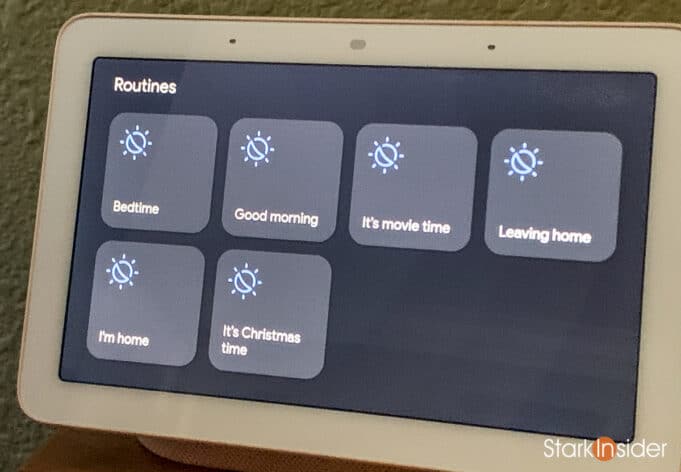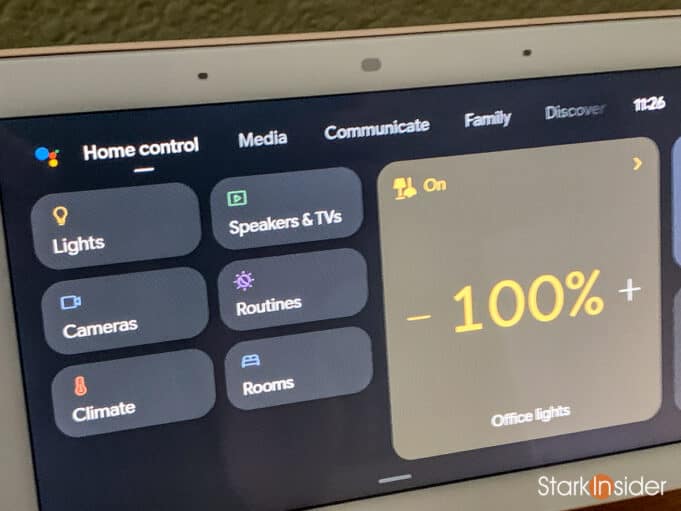Google has announced new triggers and actions for its smart home automation platform. In the blog post yesterday Google says it has added 9 new “starters” and nine new “actions.”
That means users can activate automations when a door is opened or closed, or a device starts charging, or someone walks into a room (occupancy sensing) in addition several other options listed below:
Google Home: New Starters
- Device is opened/closed
- Devices is plugged in/charging
- Temperature sensor changes
- Volume is muted/unmuted
- Device is docked/undocked
- Active light effect
- Lock is jammed
- Humidity sensor changes
- Occupancy Sensing
One of the more interesting starters is the ability to trigger an automation when a lock is jammed — this is the first time I’ve seen that on any smart home platform.
I especially like the option to do something based when a device is docked or undocked. For instance, if you routinely dock your phone to charge when sitting at a desk you could have lights turn on, and then off again when the device is removed. There’s some great possibilities here.
On the actions side, here’s what’s new:
Google Home: New Actions
- Open/close
- Pause/unpause
- Timer start/pause/resume/cancel
- Volume mute/unmute
- Dock device
- Light effects (pulse/sleep/wake/color loop)
- Reboot device
- Set humidity percentage
- Run software update
This is a pretty extensive addition. About the only thing I can think off where the competition has a significant advantage in capability would be sound identification. Amazon Alexa, for example, can start a routing when it detects a specific sound including a crying baby, coughs, water sounds, dog barking and snoring (!). It can even detect a beeping appliance. So far as I know Amazon is the only platform with this kind of sound detection feature. I’m sure Google and Apple will eventually add that as well. With AI the sky is the limit.
Automation Tab and Examples
Google says you can find all these new starters in actions under the Automation tab on the Google Home app (Android, iOS).
To ignite your auto-imagination the blog post (New starters and actions for automations now available in Home app) also has some handy examples. Here’s a few that caught my eye:
- Device is charging / plugged in: When your EV is charging, it could automatically start playing music or downloading updates.
- Device is docked / undocked: Commonly found on mops, mowers and vacuums. For example: When the vacuum docks, broadcast to the home vacuuming is finished.
- Pulse: Provide visual feedback. When the doorbell is pressed, pulse my bedroom light. (my note: good for hearing impaired)
- Wake/Sleep: When I dismiss my alarm, slowly wake the lights over a one hour time period.
- Reboot device: Quickly reboot devices like your routers, game consoles, laptop, and TV. This action could help fix problems or improve performance: Schedule a Reboot device on my router every first of the month.
Google vs. Apple vs. Amazon — now with even more AI?
The big three in the smart home space continue to be Google, Apple and Amazon with Home, HomeKit and Alexa respectively. All three have advanced voice assistants, various smart devices and speakers and apps to control everything.
Amazon was first and I think really took advantage of its first mover advantage. Low priced devices such as the Echo Dot really helped lure price sensitive buyers in the early days. Chances are the first voice command you ever tried was with an Amazon-based device and the Alexa assistant.
Apple was a little slow to market. Music seemed to be the early angle with HomePod. But with the maturation of HomeKit we’re seeing Apple finally start to approach the smart home market more holistically. The ecosystem has grown significantly — sensors and smart locks, in particular — giving buyers more choice and price options when automating their homes and AirBnbs.
Google was (and is) sort of in between. Like Amazon it offers smart displays (Nest Hub) that Apple to this day curiously does not. And its Home app has greatly improved and offers a lot of flexibility and options for those looking to dip their toe into the world of the smart home.
What about AI?
Obviously AI then is the next logical ingredient. Who knows exactly what this rapidly iterating — and often creepy — new technology will offer when it comes to life at home. I’m sure many would just as well not invite more space-age robots and cloud-computing controlled chatbots into the home. After all, there’s enough of that in the world outside, so why let it into our last vestige of escape?
Regardless, progress is inevitable. Most of the routines in these smart platforms, be it Google Home or Apple HomeKit or Amazon Alexa, are manually created. In the future perhaps AI will do all of that for us, learning by observing and taking corresponding actions. Smart thermostats such as the Ecobee and Google Nest already do that by adjusting schedules and temperatures based on behavior. (results I would say are mixed). Users can over-ride and tweak those, or completely turn that feature off, but it’s an early example of where things may be headed for the uber smart home of the not-so-distant future.
Zabriskie Point and Demon Seed
With all this accelerating tech and consumerism, I’m reminded of two cautionary tales. (excluding 1984 as the obvious one).
The first, is Michelangelo Antonioni’s rambling and existential (aren’t all his films?) Zabriskie Point (1970). A box office bomb the decidedly non-conventional love story features a challenging structure set against the backdrop of the hippie counter-revolution and an underlying anti-consumerism theme that unleashes in an explosive finale. It’s not peak Antonioni — try L’Avventura (1960), Red Desert (1964), Blow-up (1966) — but thankfully the often misunderstood, subversive film is enjoying a critical re-awakening.
Then there’s Demon Seed (1977). Donald Cammell’s take on artificial intelligence (“Proteus”) and the home, and, in particular, its relationship with human beings is quite, uh, interesting. Definitely a little silly with a clunky script, it’s still a hoot and worth a watch in light of all the recent AI buzz and emergence of the smart home.
Google says the nine new starters and actions are now available in the Home app. Have fun!



